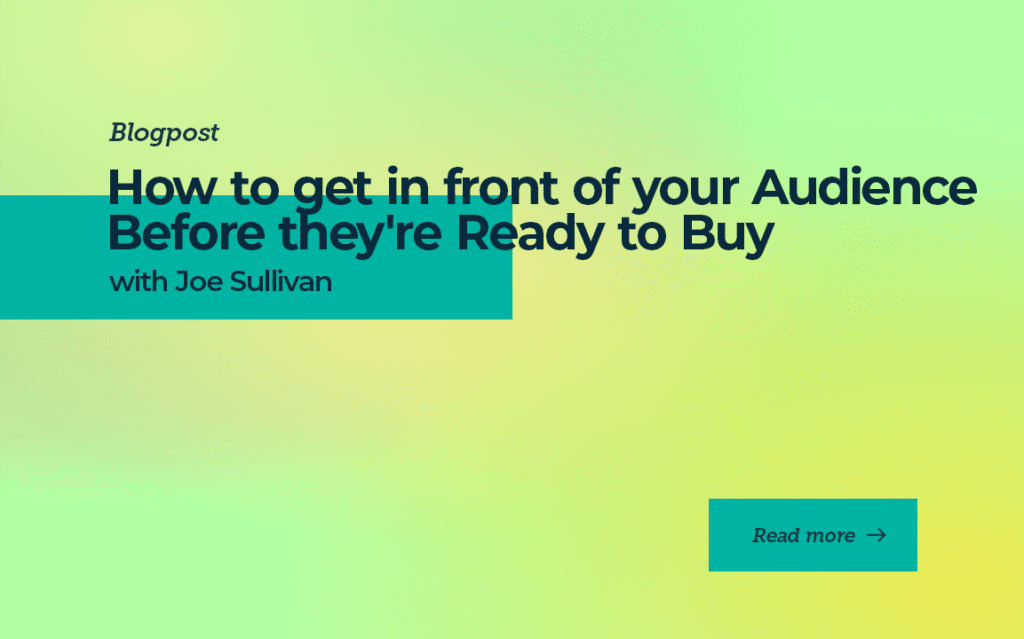How to get in front of your audience before they’re ready to buy

In this episode, we’re joined by Joe Sullivan, co-founder of Gorilla 76, a seasoned expert in the B2B industrial sector. This conversation deepens into audience-building strategies and value creation in B2B marketing, tapping into Joe’s extensive experience and insights.
Understanding how to effectively capture and engage your target audience, especially before they’re ready to buy, is crucial as the digital landscape evolves. Joe sheds light on balancing educational outreach with sales tactics and how to position your brand as a thought leader in your industry.
Why Engage Early?
Joe starts by addressing a fundamental question: why is it important to engage with potential customers before they are actively looking to buy?
Drawing from his 18 years of running a marketing agency, Joe emphasizes the significant changes in how information is gathered and how companies go to market. He highlights that most of the audience is not in the buying mode at any given time, making it essential to focus on nurturing relationships rather than hard selling.
The Reality of Buying Triggers
In industries like manufacturing, buying triggers can be infrequent and unpredictable, ranging from equipment failures to new product developments. This sporadic nature means that only a small percentage of an audience might be ready to engage in a sales conversation at any moment.
Joe explains that the traditional sales approach of cold prospecting or direct sales pitches often misses the mark, as it assumes an immediate need that may not exist.
Building Trust Through Education and Thought Leadership
Instead of pushing for sales, Joe advocates for continuous engagement. Companies can build a strong brand presence and establish trust by providing value through thought leadership and educational content. This approach ensures that when a buying trigger does occur, the company is already at the top of the customer’s mind.
Joe’s method involves helping the audience understand different solutions and educating them on new industry developments, positioning his agency as an authoritative and trustworthy source.

Mastering Organic and Paid Social
Joe shares that his commitment to organic social media is content creation and engaging actively with his network. This engagement ensures that the content reaching his feed is highly relevant and valuable to his audience, primarily in the manufacturing sector.
He describes his approach to organic social media as highly disciplined, dedicating up to 30 minutes daily to produce content that educates and adds value to his audience’s professional lives.
The strategy extends beyond posting; it includes curating a network that enhances the relevance of his social feed and participating in conversations that matter. This focused interaction increases the visibility of his content and builds a community around shared interests and expertise.
The Art of Curating a Relevant Social Feed
Curating a social media feed effectively involves a selective interaction strategy. Joe points out that engaging with content that aligns with your professional interests and goals helps tailor the social media algorithms to show more of the same, thus enhancing the quality of content on your feed.
Joe also recommends actively managing your social connections to avoid clutter and maintain a feed focused on relevant, high-quality information.
Transitioning to Paid Social Media
When discussing the transition from organic to paid social media strategies, Joe emphasizes that while both can be managed separately, they complement each other effectively.
In paid social media, controlling who sees your content and how often they see it allows for a structured narrative that can more efficiently educate, engage, and convert potential clients.
Joe explains that effective paid campaigns are meticulously planned to tell a complete story through a sequence of content exposures. This approach ensures that the audience receives educational content, social proof, and thought leadership, all tailored to resonate with their needs and challenges. An ad-tracking tool such as Voluum can be particularly useful in this context, offering advanced tracking and optimization tools to maximize the effectiveness of paid social media campaigns.
Key Takeaways for Effective Social Media Marketing
- Organic Engagement: Spend a significant portion of your time creating and sharing content that educates and adds value while engaging in the community to boost your visibility and relevance.
- Feed Curation: Actively manage who and what you interact with on social platforms to ensure your feed remains valuable and relevant to your professional interests.
- Paid Strategy Execution: Use paid strategies to deliver a targeted, coherent message sequence to your audience, enhancing the impact of your organic efforts and driving meaningful engagement.
Email as a Powerful Engagement Tool
Joe discusses the enduring value of email marketing in the B2B sector, emphasizing its effectiveness when used correctly. Unlike social media platforms governed by algorithms, email allows for direct and consistent communication with an audience.
Here’s how Joe approaches email marketing to foster engagement and trust.
The Strategic Use of Email Newsletters
Joe highlights that his company has successfully utilized email newsletters (just like ours, which has been around for a few years as well) for over 15 years, targeting a specific audience within the manufacturing industry.
The key to their success is the nature of the content shared through these newsletters.
Rather than using them as a platform for direct sales pitches, they focus on providing valuable insights and helpful information. This approach has turned their newsletters into a trusted resource, leading to high engagement and loyalty among their audience.
Content Strategy for Newsletters
The content strategy for email involves sharing educational material that helps manufacturing leaders and marketers address their challenges.
Joe treats email as a crucial distribution channel that parallels social media and traditional mail’s ability to reach and influence the target audience. The effectiveness of the email content hinges on its relevance and utility, not its ability to sell.
Cultivating Trust and Expertise Through Email
By consistently delivering valuable content, Joe’s strategy helps position his company as an expert. This established expertise means that when potential clients face a challenge or a change, like a new product launch or equipment failure, they think of Joe’s company first, thanks to the top-of-mind presence cultivated through informative email communications.
(We also invite you to check out Collin’s newsletter for Founders and CEOs)
Efficient Content Distribution Across Platforms
Joe also touches on the efficiency of content distribution, suggesting that insights shared through one channel, like LinkedIn, can be repurposed for email newsletters.
This approach saves time and tests content effectiveness across different platforms. High-performing content on social media, for instance, will likely resonate well when repurposed in an email, validating the message and amplifying its reach.
Keeping Content On-Platform for Better Engagement
Joe Sullivan emphasizes the importance of understanding how users interact with content on platforms like LinkedIn. He points out that most users don’t visit these platforms to access external content.
Instead, they prefer consuming quick, digestible snippets directly within the platform, maximizing their limited browsing time.
The Misalignment of Driving Traffic Off-Platform
Joe argues that the conventional approach of directing users to an external site can be misaligned with user preferences. This strategy often disrupts the natural browsing behavior and can lead to lower engagement rates.
He suggests that marketers need to adjust their strategies to focus on delivering value within the platforms where their audiences are already active.
Microcontent Drives More Engagement
Discussing his experience with content, Joe notes that shorter videos and posts tailored to platform-specific consumption habits tend to perform better. For instance, snippets of full episodes garner significantly more views and engagement than longer videos on YouTube.
This observation supports creating micro-content that users can quickly consume without leaving the platform.
Effective Content Repurposing
Joe also touches on the effectiveness of repurposing content and social selling across different channels. He advocates using insights from one platform to tailor content for another, ensuring it is optimized for user engagement and platform norms.
For example, successful LinkedIn posts might be repurposed into newsletter content, which continues to engage the audience without requiring them to leave their preferred platforms.
Joe advises focusing on a few key platforms to maximize impact rather than diluting efforts across too many channels. Marketers and Salespeople can more effectively allocate resources by concentrating on where they see the best engagement and results, ensuring content resonates and drives the desired outcomes.
Building Subscriber Bases Organically
Joe discusses how subscribers for newsletters can be grown organically through engaging content posted on social media platforms, which directs users to sign up for more in-depth material via email. This approach keeps the barrier to entry low and avoids overwhelming potential subscribers with aggressive sales tactics.
Marketers can significantly enhance engagement strategies and keep content relevant and engaging for their target audience by prioritizing in-platform content creation and strategically leveraging insights across multiple channels.
Transitioning from Value to Sales
Joe points out that while much of the focus in content marketing is on providing value, there must come a point where the conversation includes “sales and marketing teeth.”
He questions whether there’s a perfect ratio or specific timing for introducing sales elements, suggesting it’s more about recognizing when a potential customer shows enough buying intent to warrant a shift in the conversation’s nature.
Effective Use of Sales Conversations
According to Joe, sales efforts are most effective when they target leads that have already shown a clear interest and fit the company’s ideal customer profile. He contrasts this with the inefficiency of cold calling, which often involves contacting many leads with no guaranteed interest or intent.
This targeted approach ensures sales conversations are more likely productive and aligned with the potential customer’s needs.
Sales Enablement through Strategic Content
Joe highlights the transformation in the quality of sales conversations over the years, driven by strategic content marketing. He shares that previously, leads would arrive with minimal engagement, having spent little time understanding what his company offers.
However, now, leads come in well-informed, having engaged with various content pieces like live sessions, podcasts, or newsletters, indicating a deeper level of interest and engagement.
Marketing and Sales Alignment
The shift towards more qualified and informed leads is attributed to better alignment between marketing and sales. Marketing’s role is to educate and nurture potential customers at scale, allowing sales to engage more effectively.
Joe emphasizes that when potential customers are well-educated about the company’s offerings, they are more likely to initiate contact and be convinced of its value.
Leveraging Content in Sales Follow-up
Joe also discusses how marketing can empower sales by providing content that can be used in follow-ups to enrich the conversation further. Instead of generic follow-ups, sales representatives can provide targeted, helpful content like specific videos or case studies relevant to the discussion.
This approach continues to build trust and can significantly improve the quality of interactions, making the sales process more about meeting evident needs rather than convincing leads of value.
Conclusion
Joe emphasizes engaging potential customers early with valuable content, particularly in manufacturing industries with infrequent purchase triggers.
The discussion highlights the importance of keeping content on-platform to match browsing habits and using email as a direct communication channel to nurture leads. By aligning marketing and sales, Joe shows how educated leads are more receptive to sales, facilitating a smoother transition from informative content to sales discussions.
This strategy builds trust and positions companies as the first choice when customers are ready to purchase, enhancing overall conversion rates.
Discover how Gorilla 76 can elevate your B2B marketing strategy! Connect with Joe Sullivan for expert insights on transforming your marketing approach
Enhance your sales process with proven strategies from Predictable Revenue! Join Collin Stewart to learn how to drive growth and efficiency in your sales efforts.
NO TIME TO READ?
Listen On:





